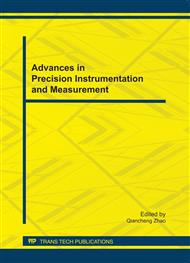[1]
Global Ozone Research and Monitoring Project", Rep. No. 47, World Meteorological Organization, Geneva, 2003(Chapter 1).
Google Scholar
[2]
V. Blanchet, P.C. Samartzis, A.M. Wodtke, UV photodissociation of methyl bromide and methyl bromide cation studied by velocity map imaging, J. Chem. Phys. 130 (2009) 034304.
DOI: 10.1063/1.3058730
Google Scholar
[3]
C. Escure, T. Leininger, B. Lepetit, Product vibrational distributions in CH3Br photo-dissociation, J. Chem. Phys. 130 (2009) 244305.
DOI: 10.1016/j.cplett.2009.08.077
Google Scholar
[4]
W.C. Price, The Far Ultraviolet Absorption Spectra and Ionization Potentials of the Alkyl Halides ,J. Chem. Phys. 4 (1936) 539.
Google Scholar
[5]
G.C. Causley, B.R. Russell, The vacuum ultraviolet spectrum of bromosilane, J. Chem. Phys. 62 (1975) 848.
Google Scholar
[6]
Bailin Zhang , Xiuyan Wang , Nanquan Lou , Bing Zhang , Jie Wei, Mass resolved MPI spectra of methyl iodide in the 430–490 nm region, Spectrochimica Acta Part A 57 (2001) 1759–1765.
DOI: 10.1016/s1386-1425(01)00388-2
Google Scholar
[7]
Andre´ T. J. B. Eppink and David H. Parker, Methyl iodide A-band decomposition study by photofragment velocity imaging, J. Chem. Phys., Vol. 109, No. 12, 22 September (1998).
DOI: 10.1063/1.477087
Google Scholar
[8]
H Kato, H Masui, M Hoshino, H Cho, O Ingólfsson, M J Brunger, P Limão-Vieira, H Tanaka. A-band methyl halide dissociation via electronic curve crossing as studied by electron energy loss spectroscopy,J. Chem. Phys. 133 (2010) 054304.
DOI: 10.1063/1.3464483
Google Scholar
[9]
L.T. Molina, M.J. Molina, F.S. Rowland, L.T. Molina, M.J. Molina, and F.S. Rowland, "Ultraviolet absorption cross sections of several brominated methanes and ethanes of atmospheric interest, " J. Phys. Chem. 86, 2672-2676 (1982).
DOI: 10.1021/j100211a023
Google Scholar
[10]
J.B. Burkholder, R.R. Wilson, T. Gierczak, R. Talukdar, S.A. McKeen, J.J. Orlando, G.L. Vaghjiani, and A.R. Ravishankara, Atmospheric fate of CF3Br, CF2Br2, CF2ClBr, and CF2BrCF2Br, J. Geophys. Res. 96, 5025-5043 (1991).
DOI: 10.1029/90jd02735
Google Scholar
[11]
L. Orkin and E.E. Kasimovskaya, Ultraviolet absorption spectra of some Br-containing haloalkanes, J. Atmos. Chem. 21, 1-11 (1995).
DOI: 10.1007/bf00712435
Google Scholar
[12]
Theodosia Gougousi, Peter C. Samartzis, and Theofanis N. Kitsopoulos , Photodissociation study of CH3Br in the first continuum,J. Chem. Phys., Vol. 108, No. 14, 8 April (1998).
DOI: 10.1063/1.475984
Google Scholar
[13]
J.G. Underwood, I. Powis, Photofragmentation of CH3Br in the red wing of the first continuum absorption band, Phys. Chem. Chem. Phys. 1 (2000) 747.
DOI: 10.1039/a907905j
Google Scholar
[14]
D. Ajitha, M. Wierzbowska, R. Lindh, P.A. Malmqvist, Spin-orbit ab initio study of alkyl halide dissociation via electronic curve crossing, J. Chem. Phys. 121 (2004)5761.
DOI: 10.1063/1.1784411
Google Scholar
[15]
C. Escure, T. Leininger, B. Lepetit, J. Chem. Phys. Theoretical calculations of self-broadening coefficients in the n6 band ofCH3Br, 130 (2009) 244306.
Google Scholar
[16]
D. Ajitha, M. Wierzbowska, R. Lindh, P.A. Malmqvist, Spin-orbit ab initio study of alkyl halide dissociation via electronic curve crossing, J. Chem. Phys. 121 (2004)5761.
DOI: 10.1063/1.1784411
Google Scholar
[17]
S. Felps, P. Hochmann, P. Brint, S.P. McGlynn, J. Mol. Spectrosc. 59 (1976) 355.
Google Scholar
[18]
R. Locht, B. Leyh, H.W. Jochims, H. Baumga¨rtel, The vacuum UV photoabsorption spectrum of methyl bromide (CH3Br) and its perdeuterated isotopomer CD3Br: a Rydberg series analysis, Chemical Physics 317 (2005) 73–86.
DOI: 10.1016/j.chemphys.2005.06.002
Google Scholar
[19]
Xing X, P Wang, B Reed, SJ Baek, and CY Ng. 2008. Infrared Vacuum-Ultraviolet Laser Pulsed Field Ionization-Photoelectron Study of CH3Br(X˜ 2E3/2)., Journal of Physical Chemistry A 112(39): 9277-9282.
DOI: 10.1021/jp8019649
Google Scholar
[20]
Fengyan Wang,M. Laura Lipciuc, Xueming Yang and Theofanis N. Kitsopoulos Multiphoton dissociation dynamics of CH3Br, Phys. Chem. Chem. Phys., 2009, 11, 2234–2240.
DOI: 10.1039/b815824j
Google Scholar
[21]
NIST Chemistry WebBook; NIST (National Institute of Standards and Technology ) Chemistry WebBook.
Google Scholar
[22]
E Biémont and C J Zeippen. Probabilities for forbidden transitions in atoms and ions: 1989-1995. A commented bibliography , Phys. Scr. 1996 192.
DOI: 10.1088/0031-8949/1996/t65/029
Google Scholar


